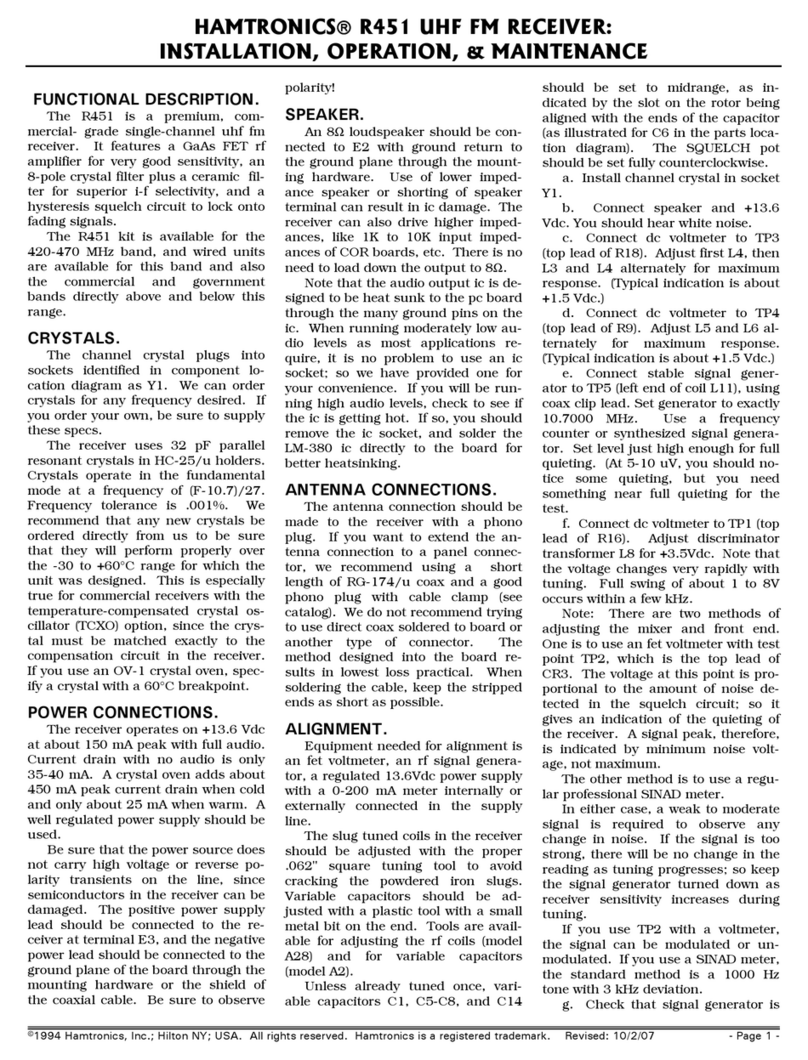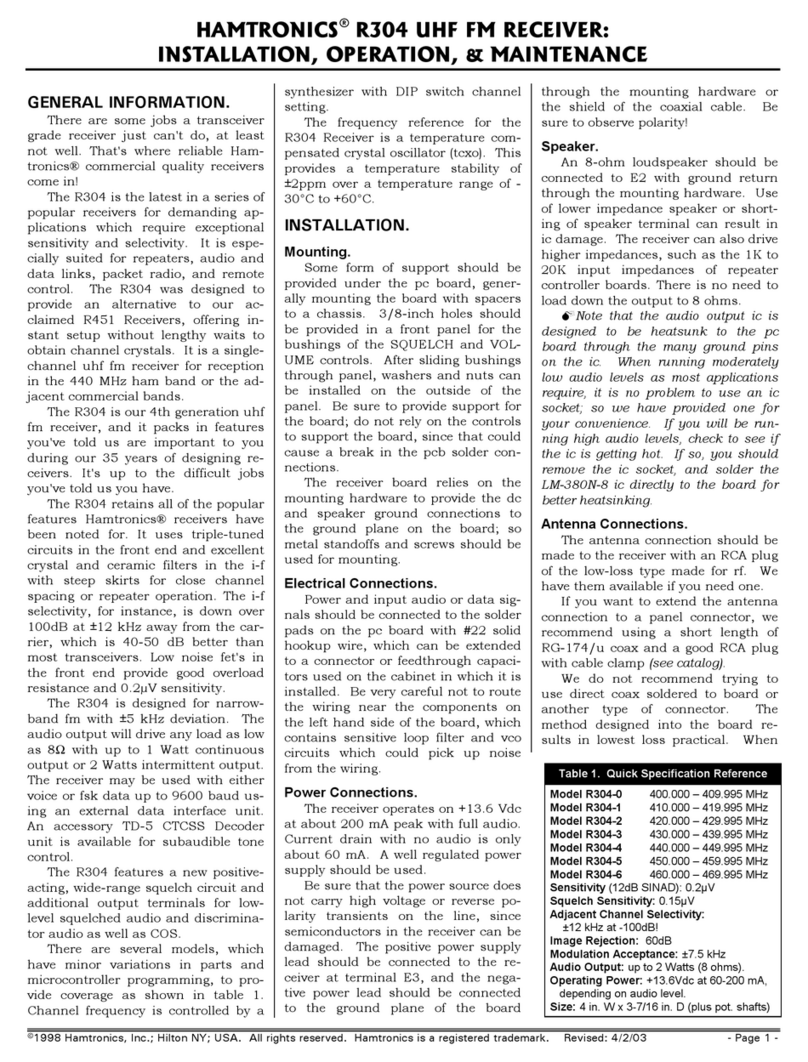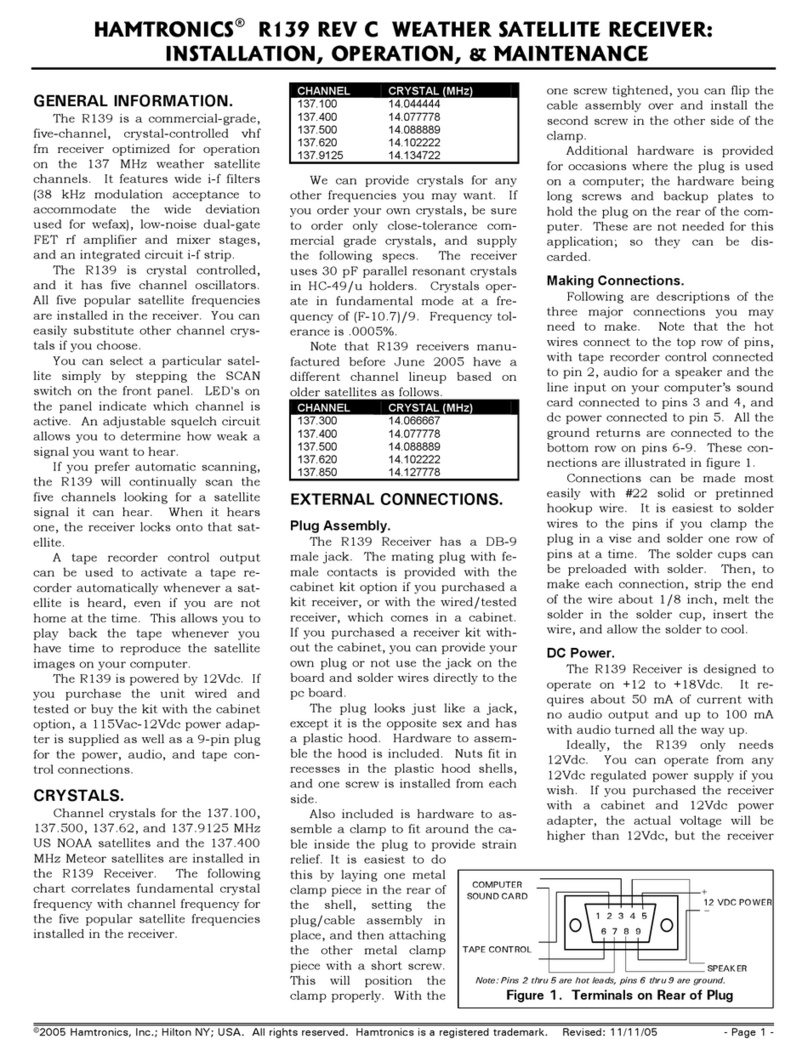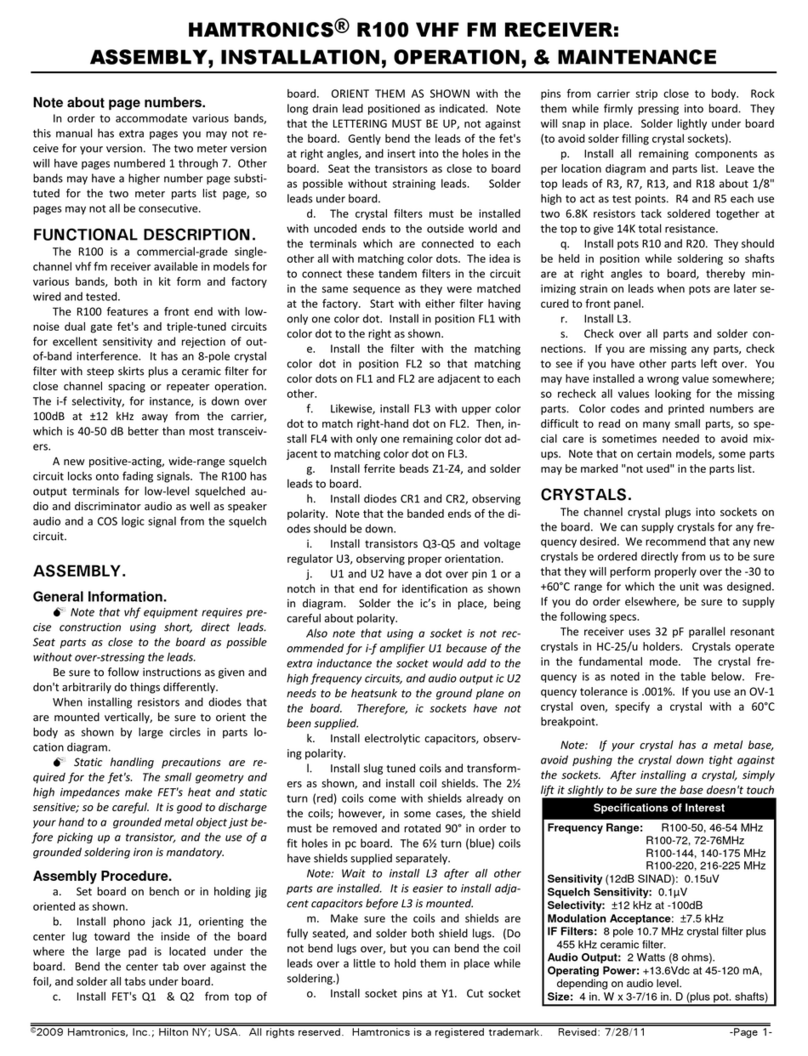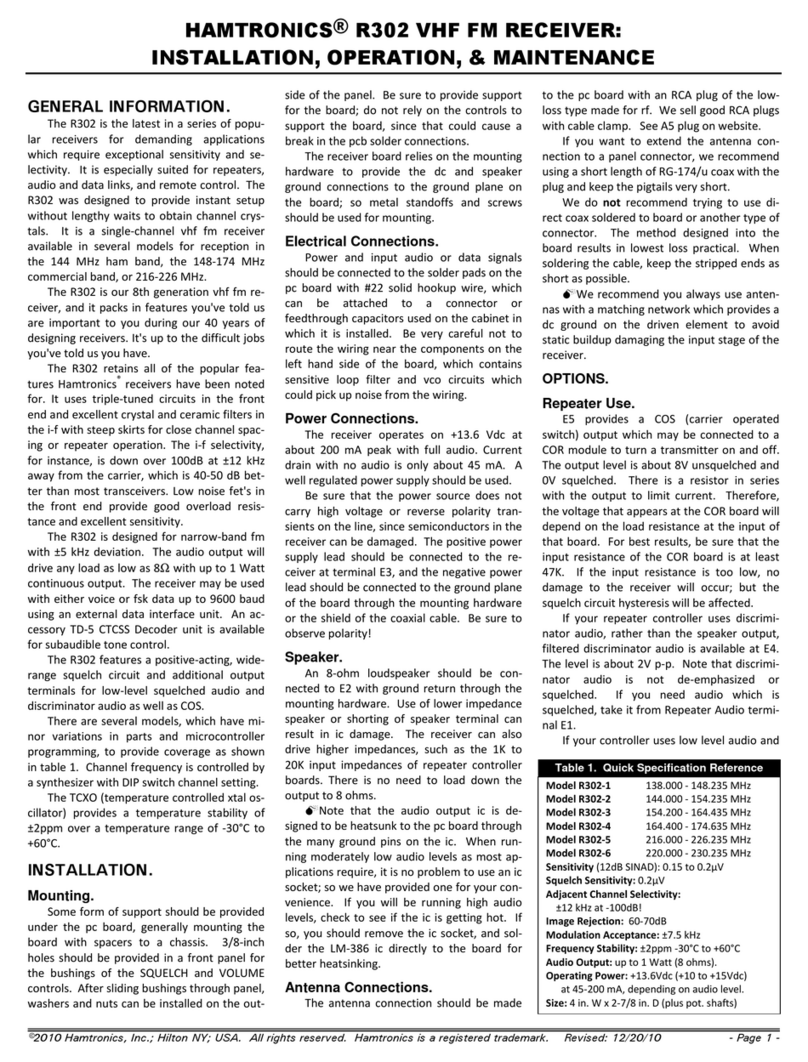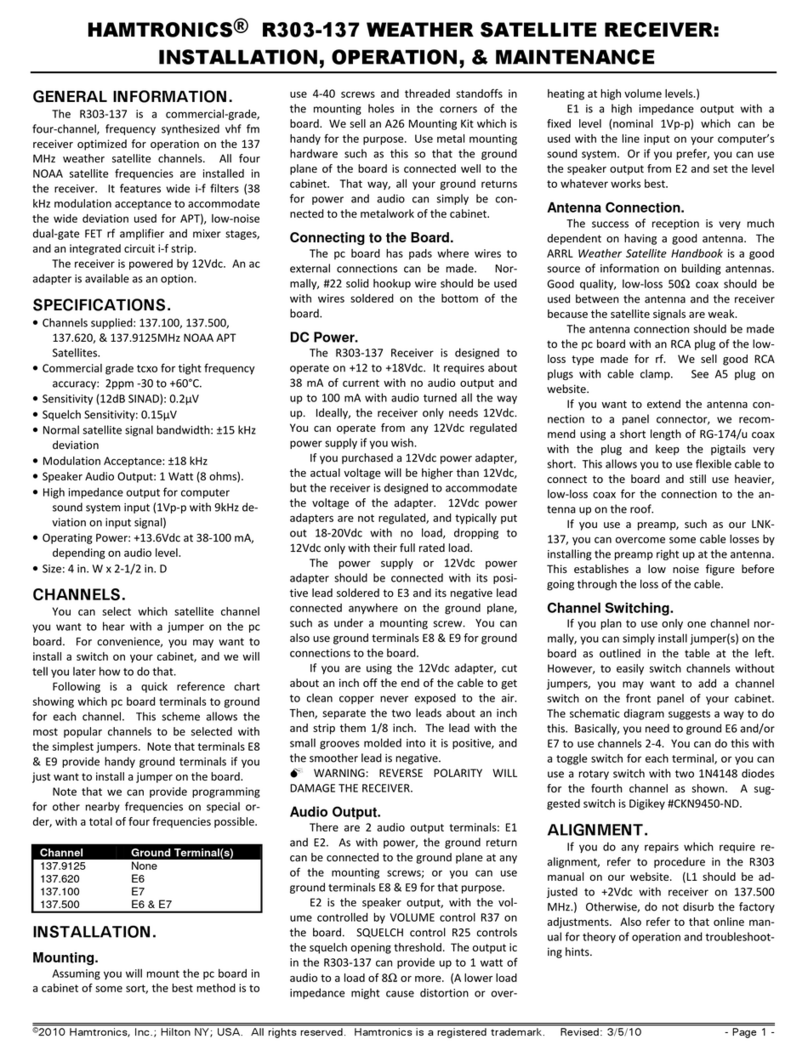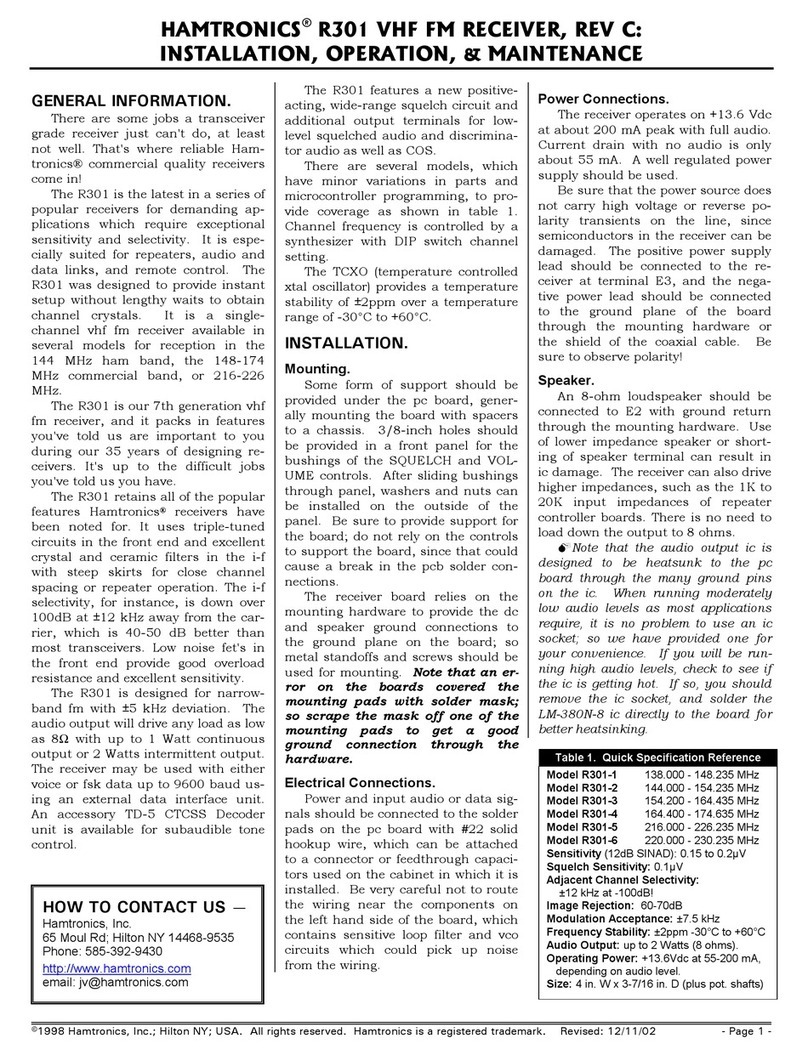
Hamtronics, Inc.; Hilton NY; USA. All rights reserved. Hamtronics is a registered trademark. evised:
limits the tuning range of D1. The tuning volt-
age is applied to D1 through a third-order low-
pass loop filter, which removes the 5kHz ref-
erence frequenc from the tuning voltage to
avoid whine.
Serial data to indicate the desired channel
frequenc and other operational characteris-
tics of the s nthesizer are applied to s nthe-
sizer U2 b microcontroller U1. Ever thing the
s nthesizer needs to know about the band, di-
vision schemes, reference frequenc , and os-
cillator options is generated b the controller.
+13.6Vdc power for the Receiver is ap-
plied at E1. Audio output amplifier U5 is pow-
ered directl b the +13.6Vdc. All the other
stages are powered through +5V regulator U6
for stabilit and to eliminate noise. Additional
filtering for the vco and buffer stages is pro-
vided b capacitance amplifier Q1, which uses
the characteristics of an emitter follower to
provide a ver stiff suppl , eliminating an
possible noise on the power suppl line.
TROUBLESHOOTING.
General.
The usual troubleshooting techniques of
checking dc voltages and signal tracing with an
RF voltmeter probe and oscilloscope will work
well in troubleshooting the R306. DC voltage
charts and a list of t pical audio levels are
given to act as a guide to troubleshooting. Al-
though voltages ma var widel from set to
set and under various operating and measure-
ment conditions, the indications ma be help-
ful when used in a logical troubleshooting
procedure.
Current Drain.
Power line current drain normall is about
38 mA with volume turned down or squelched
and up to 100 mA with full audio output.
If the current drain is approximatel 100
mA with no audio output, check to see if volt-
age regulator U6 is hot. If so, and the voltage
on the 5V line is low, there is a short circuit on
the +5Vdc line somewhere and U6 is limiting
the short circuit current to 100mA to protect
the receiver from damage. If ou clear the
short circuit, the voltage should rise again. U6
should not be damaged b short circuits on its
output line; however, it ma be damaged b
reverse voltage or high transient voltages.
Audio Output Stage.
Note that audio output ic U5 is designed
to be heatsunk to the pc board through the
man ground pins on the ic.
If audio is present at the volume control
but not at the speaker, the audio ic ma have
been damaged b reverse polarit or a tran-
sient on the B+ line. This is fairl common
with lightning damage.
If no audio is present on the volume con-
trol, the squelch circuit ma not be operating
properl . Check the dc voltages, and look for
noise in the 10 kHz region, which should be
present at U4-pin 11 with no input signal. (Be-
tween pins 10 and 11 of U4 is an op-amp ac-
tive filter tuned to 10 kHz.)
RF Signal Tracing.
If the receiver is completel dead, tr a
10.700 MHz signal applied to TP-2. Set level
just high enough for full quieting. At 20µV,
ou should notice some quieting, but ou
need something near full quieting for the test,
which requires about 200µV.
You can also connect the 10.700 MHz clip
lead through a .01µf blocking capacitor to
various sections of the cr stal filter to see if
there is a large loss of signal across one of the
filter sections. Also, check the 10.245 MHz
oscillator with a scope or b listening with an
hf receiver or service monitor.
A signal generator on the channel fre-
quenc can be injected at various points in the
front end. If the mixer is more sensitive than
the RF amplifier, the RF stage is suspect. Check
the dc voltages, looking for a damaged fet,
which can occur due to transients or reverse
polarit on the dc power line. Also, it is possi-
ble to have the input gate (gate 1) of the RF
amplifier fet damaged b high static charges
or high levels of RF on the antenna line, with
no apparent change in dc voltages, since the
input gate is normall at dc ground.
Synthesizer Circuits.
Following is a checklist of things to look
for if the s nthesizer is suspected of not per-
forming properl .
a. Check the output frequenc of the
vco buffer with a frequenc counter or spec-
trum anal zer.
b. Check tuning voltage at TP1. It
should be about +2Vdc. Actual range over
which the unit will operate is about +1Vdc to
just under +5Vdc. However, for optimum re-
sults, the vco should be tuned to allow opera-
tion at about +2Vdc center voltage.
c. Check the operating voltage and bias
on the vco, doubler, and buffer.
d. Check the 10.240 MHz TCXO signal at
pin 1 of the s nthesizer ic (actuall best to
check at pad next to pin 1; avoid tr ing to
probe surface mount ic leads which are close
together). A scope should show strong signal
(several volts p-p) at 10.240 MHz.
e. The data, clock, and latch enable lines
between the microcontroller and s nthesizer
ic’s should show ver brief and ver fast activ-
it , sending data to the s nthesizer ic shortl
after the power is first applied or a dip switch
setting is changed. Because this happens ver
fast, it can be difficult to see on a scope. Use
1mSec/div, 5Vdc/div, and normal trigger on
rising pulse.
Microphonics, Hum, and Noise.
The vco and loop filter are ver sensitive
to hum and noise pickup from magnetic and
electrical sources. Some designs use a
shielded compartment for vco’s. We assume
the whole board will be installed in a shielded
enclosure; so we elected to keep the size
small b not using a separate shield on the
vco. However, this means that ou must use
care to keep wiring awa from the vco circuit.
Having the board in a metal enclosure will
shield these sensitive circuits from florescent
lights and other strong sources of noise.
Because the frequenc of a s nthesizer
basicall results from a free running L-C oscil-
lator, the tank circuit, especiall L1, is ver
sensitive to microphonics from mechanical
noise coupled to the coil. You should mini-
mize an sources of vibration which might be
coupled to the Receiver, such as motors.
Excessive noise on the dc power suppl
which operates the Receiver can cause noise
to modulate the s nthesizer output. Various
regulators and filters in the Receiver are de-
signed to minimize sensitivit to wiring noise.
However, in extreme cases, such as in mobile
installations with alternator whine, ou ma
need to add extra filtering in the power line to
prevent the noise from reaching the Receiver.
Typical Dc Voltages and Signal
Levels.
Tables which follow give dc levels mea-
sured with a sensitive dc voltmeter on a sam-
ple unit with 13.6 Vdc B+ applied. All voltages
ma var considerabl without necessaril in-
dicating trouble. Signal levels at significant
points are also given. The charts should be
used with a logical troubleshooting plan. All
voltages are positive with respect to ground
except as indicated.
Use caution when measuring voltages on
the surface mount ic. The pins are close to-
gether, and it is eas to short pins together
and damage the ic. We recommend tr ing to
connect meter to a nearb component con-
nected to the pin under question.
Table 2. Typical Audio Voltages
Audio Test Point Normal Level*
U4-9 (Discriminator) 1.5V p-p audio
E4 (Disc Output) 1V p-p audio
E1 (Repeater Output) 600mV p-p audio
U4-11 1.5V p-p noise
(noise ampl output)
CW lug Vol Cont R32 300mV p-p audio
U5-3 (af ampl input) 0 to 100mV p-p
(depends on
volume control)
U5-5 or E2 0 to 5V p-p audio
(speaker ampl output)
* Readings taken with strong input signal
with 1000Hz modulation at ±3kHz deviation.
